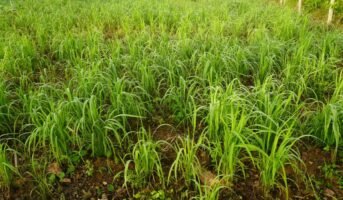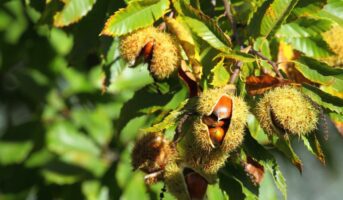Pampas grass (Cortaderia) is one of the most popular decorative grasses used in gardens. It can be found in groups, acting as a pretty screen or in lonely settings, making an eye-catching single plant. Within the sweet grass family, pampas grass constantly resprouts from its parent plant because it grows in clumps.
It originated on the grass steppe known as the Pampas, a subtropical region on South America’s southeast coast. The non-toxic plant produces huge panicles of usually silvery-white flowers in the summer, which are rather spectacular to see because their stems can reach a maximum length of 2.50 metre. But the ornamental grass also has flower fronds in other pastel tints, depending on the type. On the other hand, the wintergreen leaves reach a maximum height of one meter. There’s a huge range of leaf patterns here as well. Pampas grass is a striking exotic addition to decorative gardens because of its elegant growth and the unique height of its inflorescence.
See also: How to grow and care for an asparagus plant?
Pampas grass: Key facts
| Kingdom | Plantae |
| Class | Tracheopytes |
| Family | Angiosperms |
| Genus | Cortaderia |
| Species | C.Selloana |
| Binominal name | Cortaderia Selloana |
| Mature size | 10 foot tall, 6 foot wide |
| Sun exposure | Bright sunlight |
| Soil type | Loamy,moist but well drained |
| Native area | South America |
Pampas grass: How to grow from seeds?
Although you can easily produce Pampas grass from seeds, you may end up with spotty results and simply male grass instead of the desirable female plumes. When seeds appear on the fluffy plumes in late summer or early fall, harvest them. The seeds have sharp tips, and are long, thin and dark brown or black. On female plumes as opposed to male plumes, you will discover more seeds.
Once the seeds are harvested, do the following:
- Apply a thin layer of rich, well-draining soil over the seeds.
- Use plastic domes or bags to cover the pots.
- The pots should be placed in a bright, indirect light source.
- In roughly three weeks, germination ought to take place.
- Transfer the seedlings to bigger pots once they are manageable in size.
- Plant them outside once all chance of frost has passed and they start to resemble shrubs.
Pampas Grass: Care tips
The primary maintenance needs for pampas grass growth are listed below:
- Plant on soil that drains well and in full to partial light.
- Deeply water new plants but allow rains to feed established ones.
- As pampas grass is extremely combustible, cut it back to the ground in late winter or early spring.
- Keep pampas grass away from buildings, outdoor cooking places and open flames.
Light
This grass grows best in full sun, but it may tolerate partial sun. A soil that is very wet due to excessive shadow can result in fungal issues.
Soil
Pampas grass thrives in moist, nutrient-rich soil that drains properly. Healthy pampas grass depends on the soil’s capacity to drain properly. Because it improves drainage and enriches the soil, compost is a beneficial soil amendment for pampas grass areas.
Water
Pampas grass can withstand droughts. Unless there is a severe drought, established grasses should get sufficient water from natural rains. As soon as you plant fresh plants, give them plenty of water. To ensure the grass gets adequate water during the first few months, you might want to water it occasionally. All the water this plant will require after that will come from natural rains.
Humidity and temperature
Pampas grass grows well in warm weather. These grasses, native to South America, can tolerate extreme heat and humidity. However, these resilient grasses can also tolerate chilly winters and little snowfall.
Fertiliser
These quickly spreading grasses are not dependent on fertiliser availability or absence. After pruning in late winter or early spring, you can choose apply a well-balanced fertiliser to stimulate new growth. Follow the directions on the product package on the amount to use.
Pampas Grass: Where to grow?
This plant can tolerate moderate shade, but it prefers full sun. The plant will eventually grow to a smaller height if you decide to cultivate pampas in shade. Make sure the location you choose will work with your long-term goals for the grass because under-sunned plants can also fail to flower.
Select a location with good drainage and moist soil. One of the reasons the grass makes such excellent borders is that it is resistant to wind, drought and other environmental problems that could deter other plants. You shouldn’t worry too much about the type of soil because pampas grass doesn’t care too much about the acidity or composition of the soil.
Pampas Grass: Propagating
Ideally, pampas grass should be divided to propagate. After pruning, remove a clump off the plant using a sharp spade. After splitting the clump off from the parent plant, excavate the soil to release the roots. Remove the clump with a shovel and place it in the planned planting location. After planting, dig a hole somewhat larger than the new plant and water it.
Pampas Grass: Common problems
A tussock or crown that is overgrown can cause the plant’s midsection to become overly plump, decay or even die altogether. Replant the healthy outer circle of the plant around the garden after dividing it into multiple clumps if this occurs.
Pampas Grass: Toxicity
Animals and people alike may be poisoned by pampas grass (Cortaderia selloana). Because of its silica-like hairs, eating any part of the plant can irritate the skin and induce nausea and vomiting. Prevent any allergic responses by handling them carefully and keeping them out of the reach of kids and dogs.
FAQs
What is Pampas Grass?
Pampas Grass (Cortaderia selloana) is a tall, ornamental grass native to South America. It is known for its feathery plumes and distinctive appearance, making it a popular choice for landscaping and decorative purposes.
How tall does Pampas Grass grow?
Pampas Grass can reach heights of 6 to 10 foot or more, with its plumes extending even higher. The height depends on the specific variety and growing conditions.
Is Pampas Grass invasive?
Yes, Pampas Grass is considered invasive in some regions. Its aggressive growth can outcompete native plants, leading to ecological imbalances. It is important to check local regulations before planting Pampas Grass.
How do one should care for Pampas Grass?
Pampas Grass is relatively low-maintenance. It prefers well-draining soil and full sunlight. Water sparingly once established, as it is drought-tolerant. Prune dead or damaged stems in late winter or early spring.
Can Pampas Grass be grown indoors?
Pampas Grass is best suited for outdoor cultivation as it requires ample sunlight. It can be challenging to provide the necessary conditions for its growth indoors.
When does Pampas Grass bloom?
Pampas Grass typically blooms in late summer to early fall. During this time, the feathery plumes take on a creamy or pinkish hue, adding a unique aesthetic to gardens and landscapes.
How one should propagate Pampas Grass?
Pampas Grass can be propagated through division or by collecting and planting seeds. Divide established clumps in spring and sow seeds in late winter or early spring.
Does Pampas Grass attract wildlife?
The tall plumes of Pampas Grass can attract birds, providing a nesting and roosting habitat. However, the seeds can be a potential food source for some animals.
How to control the spread of Pampas Grass?
To prevent Pampas Grass from becoming invasive, promptly remove any unwanted seedlings and consider planting sterile varieties. Regular pruning and monitoring can also help manage its growth.
| Got any questions or point of view on our article? We would love to hear from you. Write to our Editor-in-Chief Jhumur Ghosh at [email protected] |
Anil Shah, is your go-to source for property market insights. He excels at understanding and explaining the latest trends in residential real estate and making complex real estate concepts easier to grasp. Anil’s fact-based analysis helps buyers and investors make sound decisions in the housing sector.











